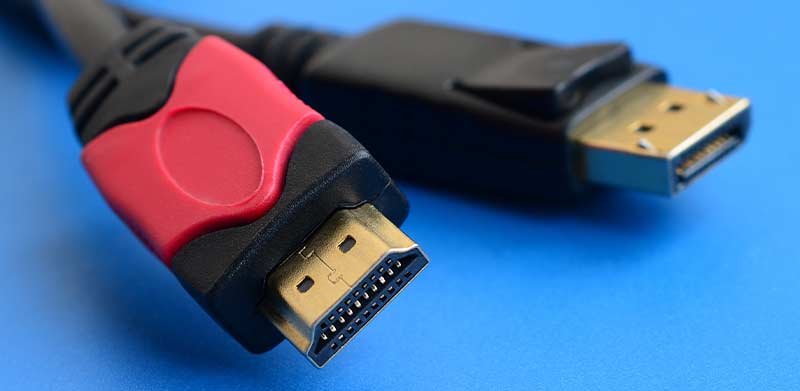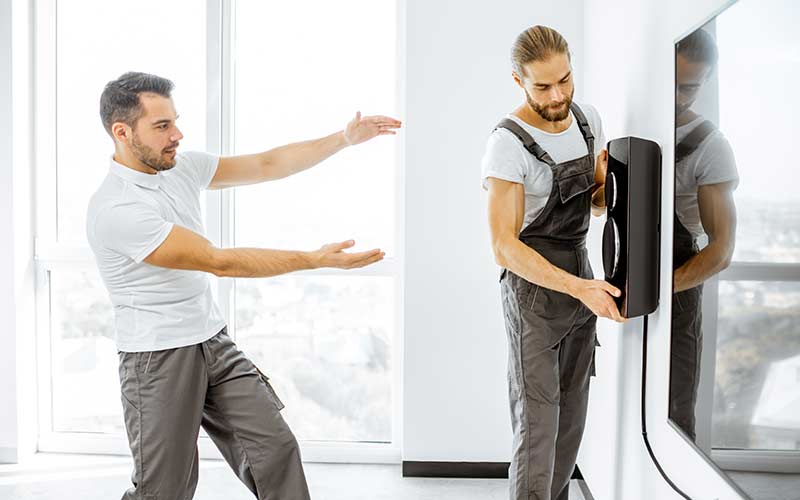Different televisions will have different inputs and outputs, but if you’re looking to output audio from your TV to a set of speakers and you don’t see an audio output on your TV, what can you do? We’ll go over all of the options, but the good news is that you don’t necessarily need an audio output on your TV in order to connect speakers – and we’ll explain why.
There are some TV’s that have dedicated outputs that are just for audio, such as TOSLINK (an optical fiber cable), or outputs that are clearly labelled as audio output. If you don’t have any of these on your TV, you can still connect speakers.
Types of Speakers for Connecting to Your TV
The first thing to consider is the type of speakers you have.
If your speakers are the traditional, un-powered style of speakers (They have a red cable and a black cable that plugs into each one), then you’ll need some sort of receiver for them. An audio/video receiver will connect to your TV and then the speakers will plug into the receiver.
Speakers that require power/amplification (from a receiver with a built-in amp) are called passive speakers. You cannot plug passive speakers directly into your television, you’ll need a home theater receiver to go in-between the television and the speakers.
There are also active speakers, which can plug directly into your television because they have amplifiers/power sources built into them. These types of speakers will connect to the back of your television, and they’ll have a variety of different input options that will allow them to connect to the TV, so it’s a matter of making sure that the input of the speakers can interfare with the output of your TV.
If your TV doesn’t have a dedicated audio output, you can still find active speakers that can connect to it. There are numerous ways to connect the speakers to the TV, let’s go over those now.
Analog vs Digital Signals for Connecting Speakers to TV

Some of these options are digital (such as HDMI), whereas other ones are analog (like RCA). Depending on what output options your TV has, it’s possible to get a converter that can turn analog signals into digital ones, so if your TV only outputs via a digital connection (like HDMI) but your speakers only accept an analog signal (like RCA), you can still make that work but in some cases it’s easier just to get different speakers or a different receiver.
Ways you can connect speakers to a TV without audio output:
- HDMI: When you think of HDMI, you probably think of it as a video or a video/audio cable, and that’s correct – but HDMI can also be used exclusively for an audio signal if you need to connect speakers. The speakers themselves, whether they’re active or passive, probably won’t have an HDMI input so that’s where the receiver comes into play. You plug the HDMI cable from the TV into your receiver, and you plug the speakers into the receiver, and the audio travels from the TV to your speakers to your ears.
- RCA cables: These analog cables can output a stereo audio signal from your TV to your speakers. If you have active speakers, you can plug these cables directly from the TV into your speakers and that should work a-ok. Otherwise, if you have passive speakers, you’ll need to connect them to a receiver, as described above. The RCA cables will connect your TV to your amplifier/home theater receiver, and the speakers will connect to the amp/receiver via traditional speaker wire.
- Headphone port: You might have an audio output port on your TV and not even realize it. If your TV has a plug for headphones on it, you can use this to connect speakers. The standard headphone jack is 1/8 inches, and is also called an “aux” or an “audio jack”. In recording studios or with higher-end headphones, you’ll also often find a 1/4 inch jack, but you can get converters to allow you to plug a 1/8 inch aux into a 1/4 inch jack, and vice versa. You’ll also find convertors to allow you to output from a headphone port into an RCA connector, which allows you to connect the headphone jack from your TV to your receiver. Alternatively, if you have active speakers, you can plug the headphone jack from your TV directly into an input on your speakers.
- DAC: A digital audio converter is a helpful device for helping you connect an analog device (in this case, your passive speakers) to a digital device (in this case, your television or receiver).
Final Thoughts on Connecting Speakers to a TV Without Audio Output
It’s possible to connect speakers to your television even if your TV doesn’t have a dedicated audio output.
It’s a good idea to use external speakers, the sound quality will be much superior to using the speakers that are built-in to your TV.
There are a number of ways to connect external speakers without a dedicated audio output on your TV, but it’s also incredibly rare (to the point that there could be the odd TV here and there, but 99.999% of TV’s will have an audio output) so unless your audio output on your TV is broken, then you should be able to use HDMI, RCA, or the headphone jack.
From there, it’s just a matter of ensuring that your speakers have the correct input to accept the output from your TV. Even if they don’t match up, there are still different connectors or converters that you can place in-between the speakers and the TV, such as a DAC, a home theater receiver, and more.
So, there you have it, that’s how to connect external speakers to TV without audio output.
